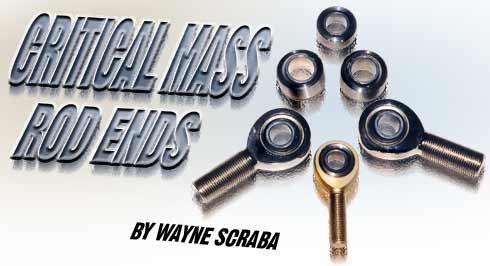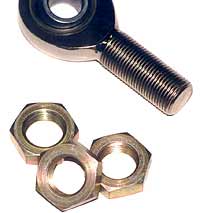
Part 2
6/7/04
Last issue, we began our look into rod ends or spherical bearings. Truthfully, rod ends are one of those "install and forget" components. Unfortunately, that isn't right. They're extremely important pieces of equipment in your racecar chassis, and if just one rod end fails in a critical location, you could have more than your hands full. This issue, we'll take a look at rod end materials, sizes and installation practices. Let's begin with the "clock":
Clocking Rod Ends
When a pair of rod ends are used in one component (such as a four link bar), the orientation of the rod ends on either end is important. This is called "clocking". But before we examine clocking, we should point out that even very small adjustments in any suspension link that sees pre-load can make a large difference in the way the car handles. In some cars, one-sixth of a turn at a time is sufficient to see a change in the behaviour of the chassis. Because of this, it's a good idea to use the "flats" (flat sides) of the jam nuts as a reference point for adjustment.
Here's how this small adjustment process works: In illustration 1 (courtesy Jerry Bickel Race Cars), you can see how a typical link is configured: One side is equipped with right hand threads while the other end of the link is equipped with left hand threads. By loosening the jam nuts, you can lengthen or shorten the entire link.
What about clocking? It's easy. Check out illustration 2 (courtesy Jerry Bickel Race Cars). As you can see, when the rod ends are properly "clocked", then they're aligned. This prevents binding of the suspension, and makes it easy to determine if the link is under tension by "feel". If you grasp the link by hand, and rotate it back and forth, you can tell if the link is neutral or under strain.
Size Matters
Aside from misalignment, there are other things to consider when selecting a rod end for a given application. From a dimensional perspective, a rod end is typically constructed two ways. The first type has a shank (the threaded segment) that is exactly the same diameter as the hole in the ball (as an example, a 3/4-inch bore coupled with a 3/4-inch shank). The next type has a shank that is one size larger than the bore (a good example is a 5/8-inch bore mated to a 3/4-inch shank). The second type (smaller bore, larger shank) has an advantage, especially where bending loads may be present. A good example is a Pro Stock style four link. In this case, we have two pairs of tubular bars acting as levers, transmitting considerable forces from the chassis to the tires (and vice-versa). In this type of application, the larger shank provides more strength along with a considerable amount of reserve strength capacity. In construction, an oversize shank is generally made by installing an insert one size smaller in the body of the part with the larger shank. Because of this, a 5/8-inch X 3/4-inch rod end will exhibit higher load capacities than a 3/4-inch X 3/4-inch rod end, provided both are manufactured from similar materials. This is due to the fact there is more body material around the insert. You'll also find asymmetrical rod ends such as this provide superior wrench access on many suspension components. Why? The fastener that goes through the center of the rod end is smaller. There is one exception to the above oversize shank construction scheme: Some companies offer a rod end where a larger shank is added to a smaller body. While this configuration serves the same purpose as the oversize shank situation mentioned above, it provides less meat around the rod end ball (simply because there's less material surrounding the spherical bearing).
Material World
We're not finished with rod end selection. There's more: Once you have the misalignment and dimensions figured out, you have to consider the elements used in the construction of the rod end. As mentioned earlier, there are a number of different materials used in the manufacture of rod ends. The balls usually are subjected to the highest loads encountered by the rod end. Because of this, they require the greatest hardness and of course, ultimate strength. Some commercial rod end balls are manufactured from bronze or even sintered steel materials. From a strength perspective, these materials aren't so hot. But there's a big caveat: Some sintered steels are fully up to the job. You see, even automotive giants like Ford Motor Company and German manufacturer, BMW have begun to use sintered steel for high stress applications such as connecting rods. And with a proper (and we mean Proper) heat treat, sintered steels can live happily in a medium duty rod end ball application. On the other hand, high quality rod ends normally incorporate heat-treated steel balls (typically chrome moly steels, stainless and 52100 bearing steels are used). In order to remain round, the balls must be extremely hard (often the balls are chrome plated to provide a smooth bearing surface). This is critical when the ball is placed under a load.
Commercial or economy rod ends usually have bodies constructed from low carbon mild steels. Because of their nature, it is not possible to through harden this material. While this less expensive material might work in a lightly loaded application, rod end bodies manufactured from chrome moly or heat treated stainless steel are far superior for severe duty applications. By using a chrome moly or stainless body, then the physical size of the rod end can be reduced (simply because the material is stronger). You'll also find that some manufacturers have used 7075-T6 material for rod end bodies. Basically, 7075-T6 aluminum is one of the strongest grades of aluminum and has a tensile strength slightly greater than mild steel. If you had a pair of rod ends with a similar design, and one was made from mild steel and the other from 7075-T6, you'd end up with similar strengths. Unfortunately, aluminum is not as forgiving (under analysis, it will not stretch or bend as much as mild steel will before breaking). And when you compare the strength of an aluminum rod end to the strength of a heat-treated chrome moly or stainless component, you'll see that the steel versions are almost twice as strong.
So what's the bottom line when it comes to materials? Unless you're absolutely positive about the loads encountered, and have a very good grasp of the limitations of aluminum rod ends, use high quality heat-treated steel models. It's better to be safe than sorry.
Finite Life & Junkyard Dogs…
Are used or surplus rod ends a good deal? In simple terms, no. Don't even think about it. Just like any other piece of hardware, a rod end has a finite mechanical life. You just don't know if a surplus or used rod end has reached it's finite cycle or not. There is no safe way to repair or "tighten" a worn bearing. Any bearing (rod end or otherwise) that has been dented in the race area or bent should be discarded. The same applies to any rod end showing any amount of stretching in the threads or the head. Any rod end that has been involved in an accident should also be checked very closely. Replacing suspect bearings is cheap insurance.
So how can you tell if a bearing is a high quality piece or not? From two feet away, it's tough to tell the far eastern sweat-shop jobs from the genuine article. Here's the secret: Look at a rod end the same way as you'd look at any precision component. Inspect the machine work. Is the surface on the race rough or smooth? The same with the ball: Is it well machined and smooth? If the rod end is a non-Teflon configuration, does the ball fit inside the body precisely or does it rattle or bind? When looking at a Teflon bearing, are there gaps in the Teflon liner or are there areas where the liner is actually loose? Basically, a Teflon lined rod end should be one continuous tightly bonded piece. As you can see, there are a number of clues as to what constitutes a quality bearing and what makes up junk.
In the end, the best rod ends are those that are designed and constructed through proper engineering and backed by a rigorous R&D program. In the real world, the rod end you're searching for should feature precision ground steel balls and it must constructed with the highest quality materials. If you don't take this approach, the only person you'll be fooling is yourself. Quality costs money. This is no place to get cheap.
 Both of
these Aurora rod ends have 3/4-inch shanks. The rod end on the left (threaded
into the trailing arm) is a standard model, while the rod end on the right is
a heavy duty model. What's the difference? The HD model has a 5/8-inch bore
while the standard version has a 3/4-inch bore. In construction, an oversize
shank is generally made by installing an insert one size smaller in the body
of the part with the larger shank. Because of this, a 5/8-inch X 3/4-inch rod
end will exhibit higher load capacities than a 3/4-inch X 3/4-inch rod end,
provided both are manufactured from similar materials. There is one exception
to the above oversize shank construction rule: Some companies offer a rod end
where a larger shank is added to a smaller body. While this configuration serves
the same purpose as the oversize shank, it provides less meat around the rod
end ball (simply because there's less material surrounding the spherical bearing).
Both of
these Aurora rod ends have 3/4-inch shanks. The rod end on the left (threaded
into the trailing arm) is a standard model, while the rod end on the right is
a heavy duty model. What's the difference? The HD model has a 5/8-inch bore
while the standard version has a 3/4-inch bore. In construction, an oversize
shank is generally made by installing an insert one size smaller in the body
of the part with the larger shank. Because of this, a 5/8-inch X 3/4-inch rod
end will exhibit higher load capacities than a 3/4-inch X 3/4-inch rod end,
provided both are manufactured from similar materials. There is one exception
to the above oversize shank construction rule: Some companies offer a rod end
where a larger shank is added to a smaller body. While this configuration serves
the same purpose as the oversize shank, it provides less meat around the rod
end ball (simply because there's less material surrounding the spherical bearing).
![]()
Just to give you an example of rod end use, have a look at this fabricated trailing
arm. This particular example is constructed from 1-1/4 X 0.095-inch chrome moly
tubing, uses two different types of welded tubing adapters incorporates high
quality jam nuts.
 As
mentioned in the text, be very careful when purchasing jam nuts. They're not
all created equal either. Like inferior rod ends, some of this stuff is absolute
junk. These particular jam nuts are from Mark Williams Enterprises and are definitely
the highest of quality. Another option is to use aircraft hardware.
As
mentioned in the text, be very careful when purchasing jam nuts. They're not
all created equal either. Like inferior rod ends, some of this stuff is absolute
junk. These particular jam nuts are from Mark Williams Enterprises and are definitely
the highest of quality. Another option is to use aircraft hardware.
| Sources | |
|
Aurora Bearing Company
970 S. Lake Street Aurora, IL 60506 PH: 630-859-2030 |
Jerry Bickel Race Cars
141 Raceway Park Drive Moscow Mills, MO 63362 PH# 636-356-4727 |
Copyright 1999-2004, Drag Racing Online and Racing Net Source